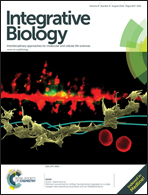Investigating the mechanical properties of zona pellucida of whole human oocytes by atomic force spectroscopy†
Abstract
The role of mechanics in numerous biological processes is nowadays recognized, while in others, such as the fertilization process, it is still neglected. In the case of oocytes the description of their mechanical properties could improve the comprehension of the oocyte–spermatozoon interaction and be helpful for application in in vitro fertilization (IVF) clinics. Herein the mechanical properties of whole human oocytes (HOs) immediately after retrieval are investigated by indentation measurements with atomic force spectroscopy under physiological conditions. Measurements are performed on immature (metaphase I – MI) and mature (metaphase II – MII) HOs. According to their morphological characteristics MII-HOs are classified as “suitable” and “rejected”; these latter would be usually rejected for intracytoplasmic sperm injection (ICSI). For all maturation stages we observe that the elastic response of the zona pellucida (ZP) outer layer was different and distinguishable from the rest of the ZP-HO. The elasticity of this ZP outer layer varies with maturation and quality: stiffness decreases from immature MI to good quality MII, up to poor-quality rejected MII. An indirect analysis with IVF outcome indicates that the ZP outer layer of analysed HOs donated by women who achieved pregnancy is stiffer than that of HOs from women with negative outcome. Our findings suggest that mechanical properties can represent important oocyte quality indicators that may be exploited for the design of innovative ICSI dedicated cell sorters.


 Please wait while we load your content...
Please wait while we load your content...